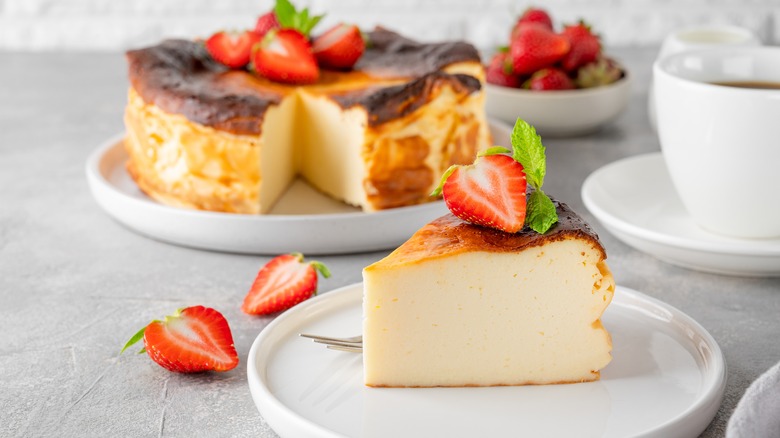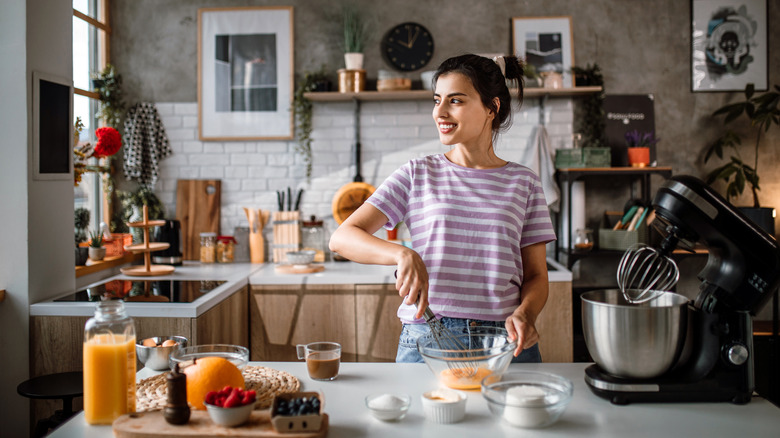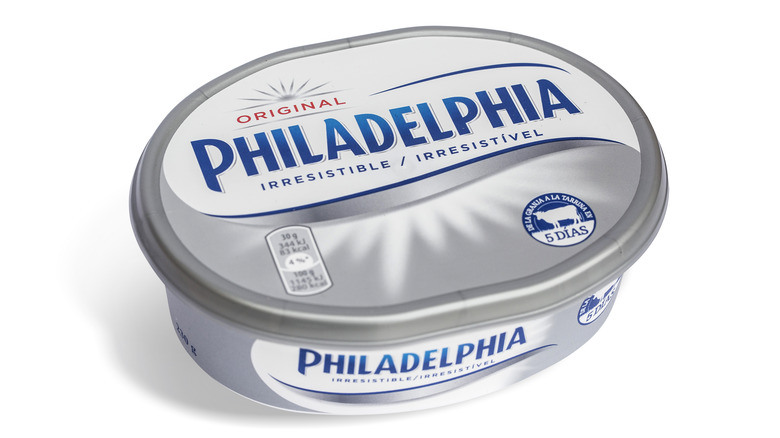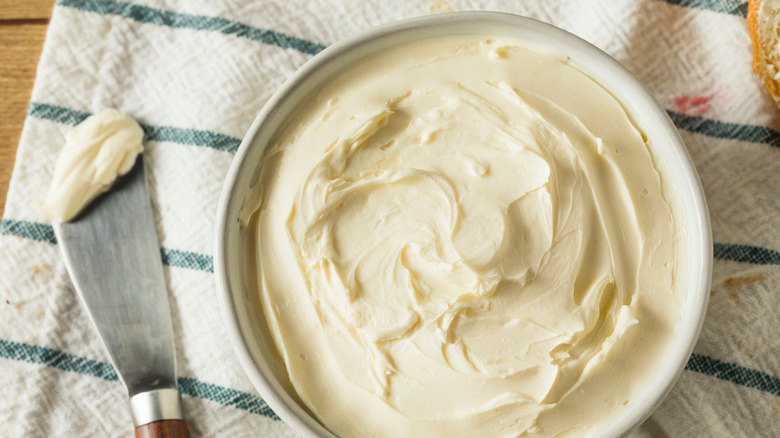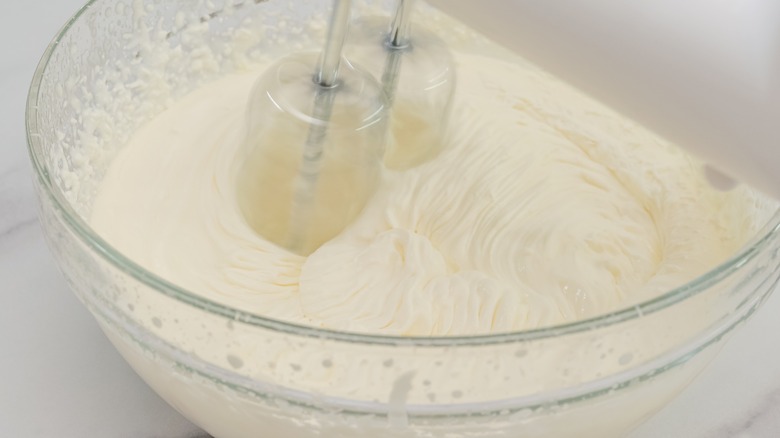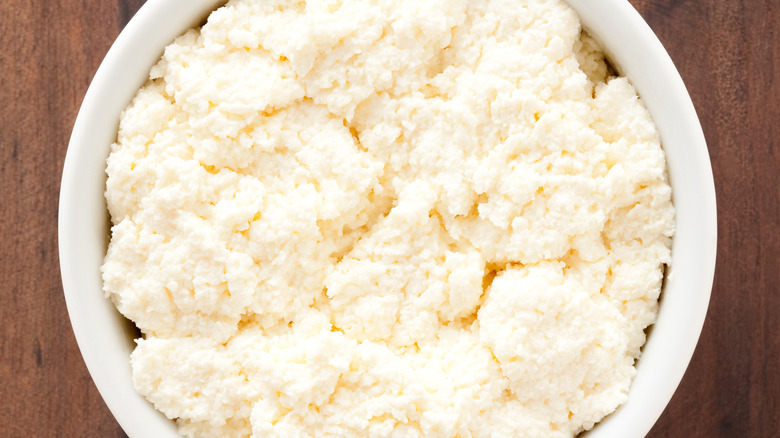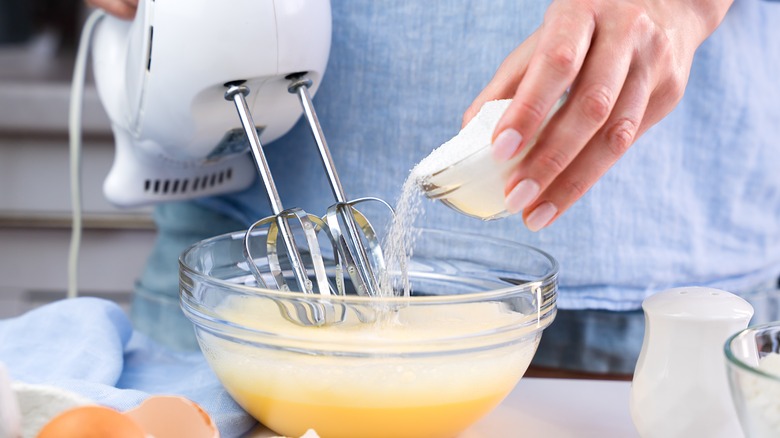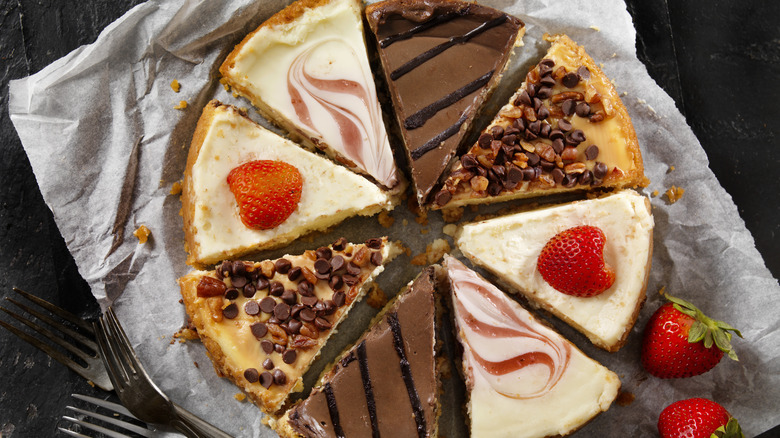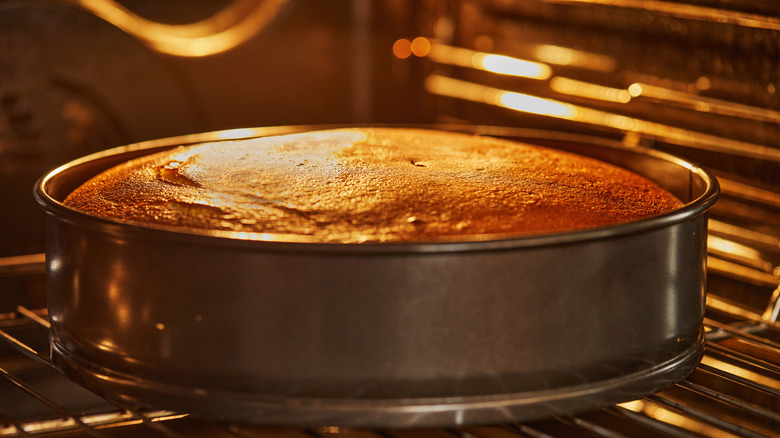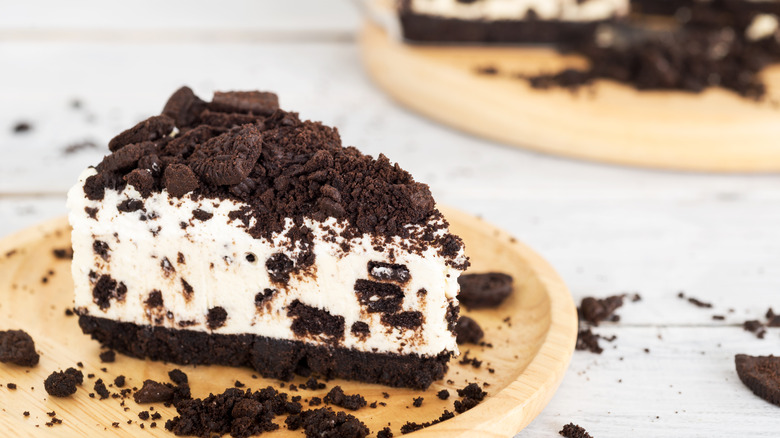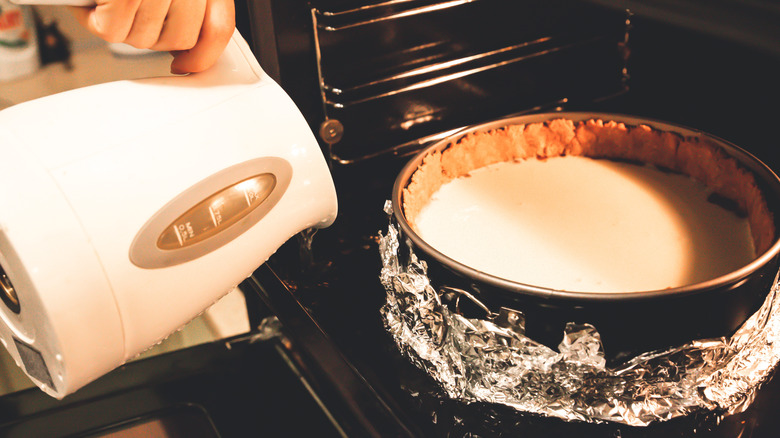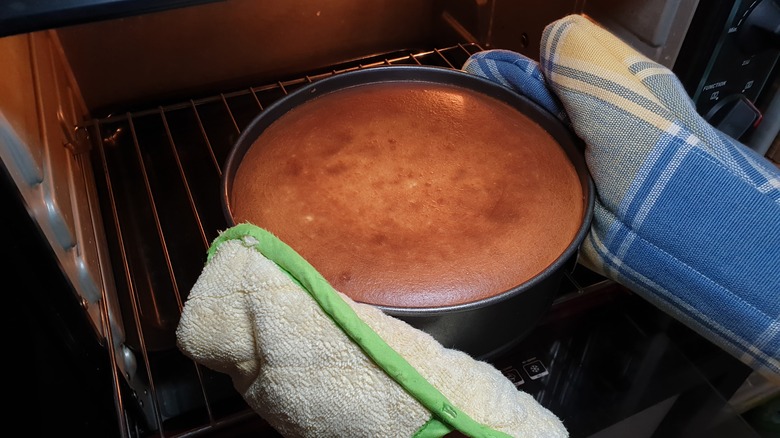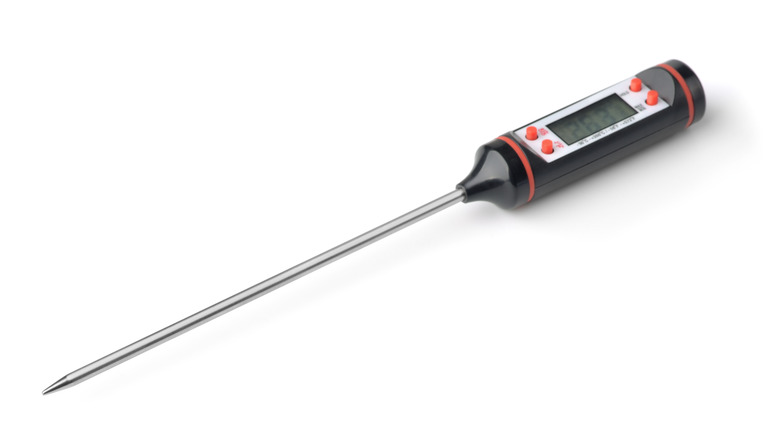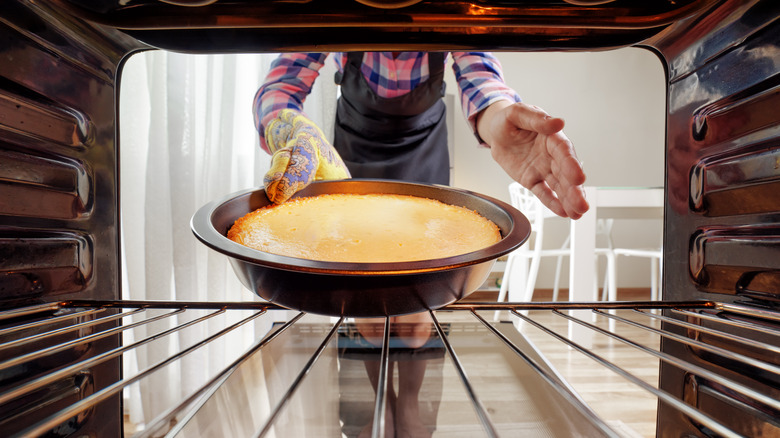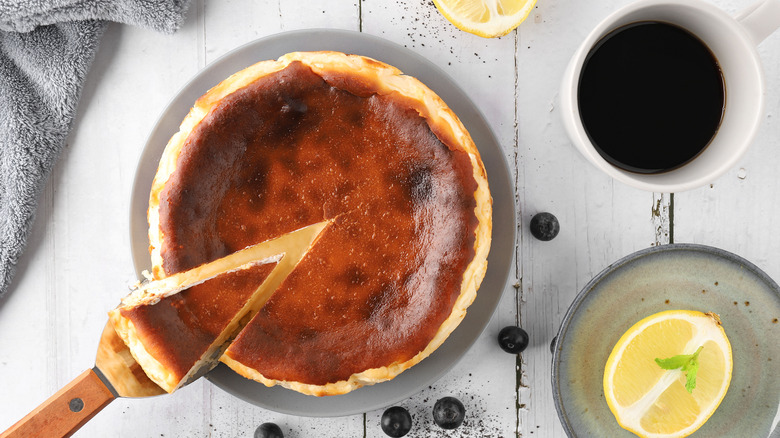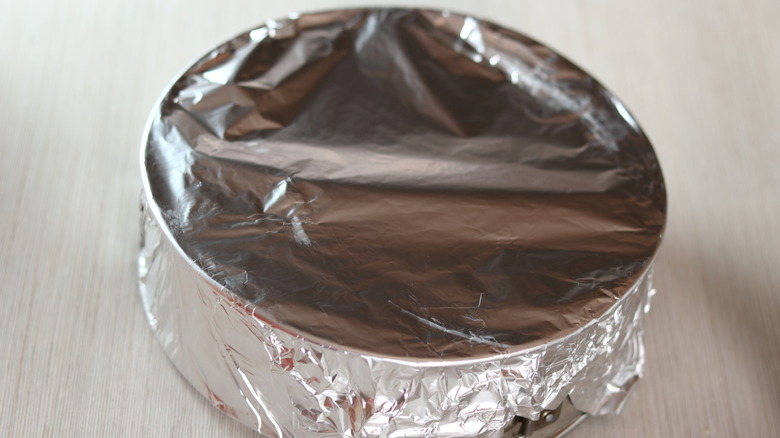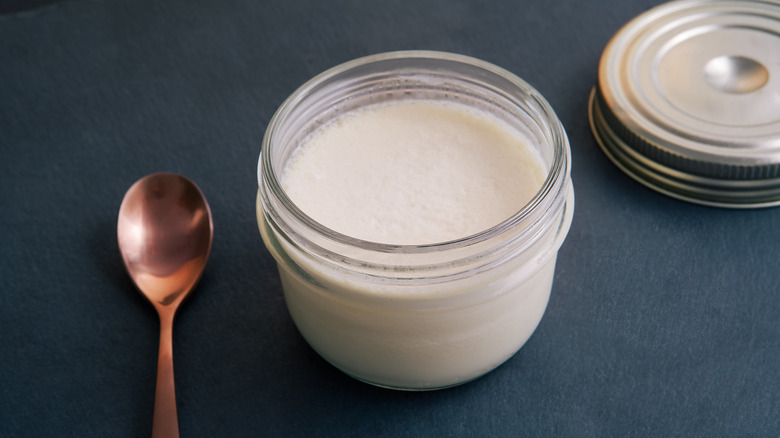16 Mistakes You're Making With Homemade Cheesecake
Although cheesecake technically isn't considered a cake because it's made without leavening or traditional cake ingredients, this dessert has a very special place in all of our hearts. There are numerous varieties of cheesecake to enjoy, which encompass a broad range of ingredients, cheeses, and cooking styles. The New York-style cheesecake is one of the most well-known in the U.S. It's a very dense custard made with the rich addition of heavy cream and egg yolks, complete with a graham cracker crust. This style of cheesecake stands in stark contrast to the Japanese, or souffle, cheesecake, which features a wobbly texture and significantly less hefty ingredients than the American preparations. You'll also find no-bake cheesecakes made with ample amounts of cream cheese and no eggs, as well as varieties like the Basque cheesecake that are crisped to perfection.
Regardless of what kind of cheesecake you're making, there's no doubt that the process of getting there can be a bit intimidating — especially for the comparatively finicky baked cheesecakes. Here are some of the mistakes you might be making with your cheesecake recipe, resulting in disastrous cracks, poor textures, and an overall disappointing slice.
Working with cold ingredients
Using room-temperature ingredients is a rule told to all bakers. But it is essential to use room-temperature ingredients for making cheesecake because the ingredients will blend much more seamlessly than if you pulled them straight from the fridge. This rule applies to cream cheese, eggs, and butter — which together form an air-trapping emulsion in the batter. As the cheesecake bakes, the trapped air produces a soft, plush texture rather than a stodgy one.
Even if you're making a no-bake cheesecake, you should be concerned about the temperature of your ingredients. Cold cream cheese can ruin a no-bake cheesecake because it will leave unsettling lumps throughout the filling. You should remove the cream cheese packages from your fridge about an hour before you plan to start assembling the cake. You can also cube the cream cheese brick into smaller pieces to allow the air to warm it up faster.
Using whipped cream cheese
One of the biggest mistakes people make with cheesecake occurs before any ingredients hit the bowl. When you're sourcing your cream cheese, you should always go for the blocks of it; never use whipped cream cheese for cheesecake. The cream cheese that comes in a block and the product that comes in a tub are two different products that are not entirely interchangeable in a recipe. Blocked cream cheese contains cheese cultures, while the tubbed cream cheese is treated with lactic acid. While the lactic acid does make this cream cheese easier to use and cheaper, it results in a much grainier cream cheese that can turn your cheesecake into a textural disaster. When a cheesecake made with whipped cream cheese is cooked, it leaks water because of its unique protein structure.
In addition, whipped cream cheese has a much higher air content than the dense brick of cream cheese, which further produces a disequilibrium of ingredients and textures. If you only have whipped cream cheese on hand, stick to a no-bake cheesecake recipe and weigh your ingredient out rather than measuring them via volume.
Using low-fat cream cheese
Whipped cream cheese isn't the only product you should refrain from reaching for when you're making cheesecake. If you use any low-fat ingredients in your cheesecake, you risk altering the texture of the cheesecake entirely.
While some online recipes will tout "low-fat cheesecake" headlines, you should always proceed with some skepticism. Low-fat cream cheese, in particular, contains more moisture than regular cream cheese. As a result, cheesecakes made with low-fat cream cheese tend to come out much more watery and less structurally sound. In addition, research published in the International Journal of Food Science and Technology notes that the fat in cream cheese is the primary agent responsible for the decadent, dense mouthfeel of cheesecake. If you remove even some of that fat, you won't have the same consistency or structure. If you have to use low-fat cream cheese, we recommend looking for a recipe specifically tailored to the high moisture content of the low-fat cream cheese rather than making substitutions.
Undermixing your cheesecake
It's finally time to start mixing your cheesecake ingredients together! But like all of the other steps of the cheesecake-making process, you'll need to proceed cautiously. If you under-mix your cheesecake ingredients, your batter will be relegated to a chunky, cloggy mess — not the smooth, creamy texture you need for a proper cheesecake. For the best texture, try to mix your ingredients in two separate batches — the first with just the cream cheese and the second when you fold the eggs and other ingredients in.
Under-mixing isn't the only precarious part of making cheesecake. Over-mixing can also lead to textural issues such as cracking and collapsing because you beat too much air into the batter. To avoid this, follow the two-step mixing sequence. First, you'll only need to whip your cream cheese until it's creamy. Then, fold in the other ingredients so that they are all incorporated — but not any further.
Not diversifying your cheeses
Cream cheese is, of course, the most popular kind of cheese used for making cheesecake. But you can make many other variations of cheesecake with different types of cheese, such as ricotta, mascarpone, and quark. Our recipe for baked ricotta cheesecake includes 28 ounces of whole milk ricotta cheese and 8 ounces of cream cheese; this ratio lends well to the quirky, tangy flavor of the ricotta with the structural support of the cream cheese. Mascarpone is particularly useful in cheesecakes because it has a high fat content. It's the base of our tiramisu cheesecake — which we think is the best of all of the dessert worlds.
Quark is a more niche type of cheese that is not as readily found in American grocery stores as mascarpone or ricotta. It's used to make a classic German cheesecake and has a texture and taste similar to that of Greek yogurt.
Not being careful with your eggs
Most baked cheesecake recipes will include eggs. The eggs, more specifically the yolk, make the custardy batter more creamy. This is due to the emulsification that occurs when the proteins and fats in the eggs intermingle with the other ingredients. Besides making the batter more custard-like in flavor, the emulsification also helps the batter set and become spongy. In contrast, no-bake cheesecakes do not include eggs and are subsequently more like cream cheese puddings encased in a cookie shell.
Now that we know that eggs are a big deal in cheesecake, we can talk about the pitfalls of adding eggs to the cheesecake. If you add too many eggs or whip the eggs too much (more whites than yolks), your cheesecake will resemble a soufflé. Cold eggs can also ruin your cheesecake because they will cause the entire batter to seize up around it and produce a lumpy batter. In short, treat your eggs like the critical ingredient they are in cheesecake.
Only making plain cheesecake
Will anything come close to the beauty of a well-made, original cheesecake? No, but that doesn't mean you can't play with and incorporate other flavors into your recipe. You can mix and match your flavor profile to almost anything. Surprise your loved ones during the holiday season with a gingerbread cheesecake with a crumbled gingerbread cookie base, spiced brown sugar and molasses filling, and decorative gingerbread men and cream topping. If you don't have the patience to bake a cheesecake, try making a no-bake strawberry cheesecake with whipped topping, cream cheese, strawberry jam, and fresh strawberries — or substitute the strawberry ingredients with blueberry or raspberry jam and berries.
Another popular cheesecake combination is undoubtedly chocolate. Make a simple no-bake chocolate cheesecake flavored with cocoa powder and melted semi-sweet chocolate chips. You can further upgrade this recipe by swapping out the graham cracker crust with one made with chocolate sandwich cookies or chocolate graham crackers.
Baking in anything but a springform pan
Springform pans are a necessity for cheesecake-baking enthusiasts. Unlike traditional baking pans, springform pans have a collar that can be easily popped off when your cake is cooled and set; you won't have to worry about wedging the entire cake out of the pan. In addition, the sides of the springform pan are higher than traditional baking pans, allowing you to get a taller cheesecake than if you used a standard pie plate.
If you're using a springform pan, you need to take a few essential precautions. First, always line your springform pan with parchment paper on the inside and a layer of aluminum foil on the outside. Even if your springform pan is marketed as being "leak-proof," you're still baking a runny batter in a pan without a perfect seal between the base and the collar. The aluminum foil exterior will further prevent leakage (as if anyone likes cleaning burnt food off their oven) and provide a buffer from the water bath.
Using a boring crumb crust
If you're not enhancing the filling of your cheesecake with any unique ingredients, you might take some creative license and play with the flavors of your crumb base. Although graham crackers are the quintessential base for cheesecake, other types of cookies can make a flavorful crumb crust too. It's always important to use crunchy cookies because the soft ones will get soggy and disintegrate when you add your filling. Our favorite cookies to use include Biscoff cookies, Nutter Butters, and even fortune cookies. Try crumbling up Ritz crackers, Saltines, or pretzels if you want a less sweet base. To make your crumb crust, add whole cookies or crackers to a food processor and pulse until fine. Next, add melted butter and sugar (the amount depends on the type of cookie or cracker you use) and firmly push it into the tin.
Regardless of the type of crumb crust you use, you'll need to bake it in the oven for about ten minutes before adding your filling. This will prevent the dreaded "soggy bottom" and keep your crust crisp for serving.
Skipping the bain-marie
If you're not a frequent cheesecake baker (or watcher of copious amounts of baking television), you may not know what a bain-marie is. A bain-marie, which translates to "Marie's bath" after the person who invented the technique, is a method of cooking cheesecakes to prevent cracking. The bain-marie method involves placing the baking dish in a larger pan or dish filled to the middle of the cheesecake tin with hot water.
The water causes the cheesecake to cook indirectly, while the steam from the water prevents the top of the cheesecake from drying out — which is the primary reason why the cheesecake cracks. In addition, the bain-marie method can prevent your cheesecake from sinking because it mediates the cooking process to prevent curdling and provides a temperature buffer for when you're ready to turn off your oven. The bain-marie method is helpful for many different types of fussy custards and bakes — and it's essential for baking a good cheesecake.
Pulling your cheesecake out prematurely
How do you tell if a cake is done? For conventional cakes, like yellow or chocolate cake, you'd use a cake tester to ensure it comes out clean before removing it from the oven. However, this trick would not work for a cheesecake since poking it with a toothpick or tester would just cause it to crack. Instead, you have to be a bit more technical to determine when to shut off your oven.
The absolute best way to tell when your cheesecake is done is to perform a jiggle test. Reach into your oven and gently shake your cheesecake. If you're using a bain-marie, you'll want to be very careful when navigating your hand into the oven, as jiggling the pan may cause steam or hot water to splash out and burn you. You can also use a wooden spoon to tap the side of the pan instead. You're looking for a small amount of jiggle from the middle of your cheesecake. Your cheesecake will continue to cook after you shut the oven off, so this amount of bounciness is permissible. But if your whole cake is shaking like an ocean wave, you must leave it in the oven for much longer.
Not checking your cheesecake's temperature
The temperature of your cheesecake can also tell you if it's finished cooking. You should take your cheesecake's temperature to ensure it's cooked through if your jiggle test makes you question if it's truly finished baking or not. If you decide to remove the cake prematurely, you may find that the cake sinks and is raw in the middle. But if you wait too long, your cheesecake may come out rubbery. A number is a more finite way to decide when the perfect time is to pull your cheesecake out compared to a jiggle test — which requires a more acutely trained eye.
Your cheesecake should be between 150 and 170 degrees Fahrenheit when it's time to shut the heat off. Poke your cheesecake with a thermometer so it's sitting about halfway through the middle of the cake before taking the reading. It's important to avoid constantly opening and re-opening the oven to check the temperature or progress of your bake because the temperature change may cause the cake to sink.
Rushing your cheesecake out of the oven
The idea for most cakes is that you bake them and promptly remove them from the oven to finish the cooling process on the counter. But cheesecake, as always, is the outlier. You can't rush your cheesecake out of the oven — it's the important step you need to make when chilling your cheesecake.
Unlike other types of cakes, cheesecake needs to cool gradually to prevent it from sinking or cracking. If you make the rash decision to pull your cheesecake from the oven and plop it on the countertop, the temperature change will cause a massive crack to form on the top of your otherwise perfect cheesecake. Instead of making this cooling mistake, keep your cheesecake in the oven and open the oven slightly to allow some of the heat to escape. Once the oven has cooled down, you can safely transfer your cheesecake and bain-marie to the countertop.
Forgetting to loosen the edges
Cheesecake, finicky? No way!
Yet another issue you may encounter with your cheesecake comes when it's finally time to slice it. If you notice your cheesecake starts to slump in the middle, it's likely because you didn't separate the cake's edges from the pan. So the next time you bake a cheesecake, try to run a knife or spatula along the edges of the cake when you first shut off the oven and before you leave the cake in to finish cooling.
Another slicing snafu many folks find themselves in with cheesecake occurs during serving when the first slice comes out perfectly clean, but the second comes out like a muddy mix of layers. This is because the filling and the crumbs stick to the knife and inhibit the perfect slice. Always wipe your knife off with hot tap water after each slice to keep your slicing neat.
Covering cheesecake while it's still warm
Nobody likes a soggy bottom — especially the judges of the "Great British Baking Show." Even if you use the crispiest graham cracker crust rather than a shortcrust base, you may not be immune to this common cheesecake phenomenon. And not only does the soggy bottom form as the result of the crust not being baked before adding the filling or some miscalculation in the moisture of the filling but also because of improper storage techniques.
To avoid a soggy bottom, you should never cover cheesecake while it's still warm. If there is any bit of heat left in your cheesecake, covering it with foil and putting it in the fridge will only cause condensation and cause your crust to lose all of its crispiness. Instead, you should leave your cheesecake on the counter for at least two hours after removing it from the oven. Once your cheesecake is completely cool to the touch, wrap it in plastic wrap (this will prevent all of the smells from your fridge from permeating into your cheesecake) and refrigerate it.
Not trying sous vide cheesecake
The bain-marie is an appropriate method for cooking a standard cheesecake, but there might be another method in your kitchen that allows you to make pint-sized versions of this classic dessert. Instead of turning to your water bath, you can try to sous vide your cheesecake. The sous vide performs a very similar function as the bain-marie; it heats water to a certain temperature before food can be fully submerged into the machine. The sous vide maintains a consistent temperature, which helps reduce the risk of cracks and sinking.
You'll need to use air-tight containers like mason jars for this technique. Four-ounce jars of cheesecake should be cooked at around 176 degrees Fahrenheit; any warmer may cause the cheese to curdle. Besides a superior texture with the sous vide machine, making small batches of cheesecake also allows you to personalize the cheesecakes and explore small-batch flavors you may not have otherwise tried.
Static Media owns and operates Tasting Table, Mashed, and The Daily Meal.
